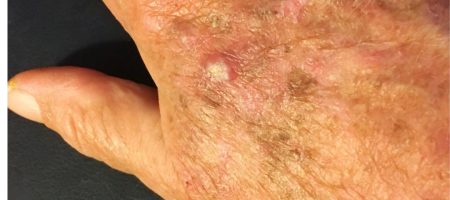Actinic Keratoses

Actinic keratosis is a precancerous scaly spot found on sun-damaged skin, also known as solar keratosis. It may be considered an early form of cutaneous squamous cell carcinoma (a keratinocyte cancer).
Symptoms
Actinic keratoses are often more easily felt than seen, they may be solitary but there are often multiple keratoses. Skin may feel dry and rough to the touch, or raw, sensitive and painful, or even itchy with a pricking or burning sensation. Some actinic keratoses look and feel inflamed. In rare instances, they may bleed or develop a persistent sore, also known as an ulceration. In other cases, they come and go in the same spot.
The appearance of actinic keratosis can be:
- A flat or thickened papule, or plaque
- White or yellow; scaly, warty, or horny surface
- Skin coloured, red, or pigmented
- Tender or asymptomatic
It’s often found on the face, lips, ears, forearms, scalp, neck or back of the hands.
Causes
Actinic keratoses are the result of abnormal skin cell development due to DNA damage by short wavelength UVB.
They are more likely to appear if the immune function is poor, due to ageing, recent sun exposure, predisposing disease, or certain drugs.
Treatments
Actinic keratoses are usually removed because they are unsightly or uncomfortable, or because of the risk that skin cancer may develop in them.
Treatment of actinic keratosis requires removal of the defective skin cells. The epidermis regenerates from surrounding or follicular keratinocytes that have escaped sun damage.
Tender, thickened, ulcerated, or enlarging actinic keratoses should be treated aggressively. Asymptomatic flat keratoses may not require active treatment but should be kept under observation
Resources
For further information, you can visit the following resources:

